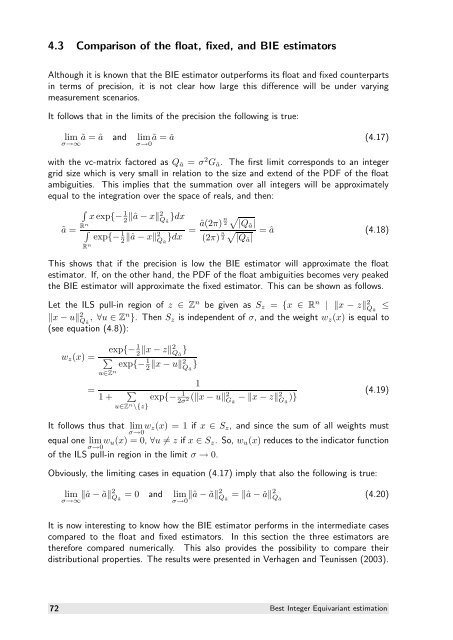The GNSS integer ambiguities: estimation and validation
The GNSS integer ambiguities: estimation and validation
The GNSS integer ambiguities: estimation and validation
You also want an ePaper? Increase the reach of your titles
YUMPU automatically turns print PDFs into web optimized ePapers that Google loves.
4.3 Comparison of the float, fixed, <strong>and</strong> BIE estimators<br />
Although it is known that the BIE estimator outperforms its float <strong>and</strong> fixed counterparts<br />
in terms of precision, it is not clear how large this difference will be under varying<br />
measurement scenarios.<br />
It follows that in the limits of the precision the following is true:<br />
lim<br />
σ→∞<br />
ã = â <strong>and</strong> lim ã = ǎ (4.17)<br />
σ→0<br />
with the vc-matrix factored as Qâ = σ2Gâ. <strong>The</strong> first limit corresponds to an <strong>integer</strong><br />
grid size which is very small in relation to the size <strong>and</strong> extend of the PDF of the float<br />
<strong>ambiguities</strong>. This implies that the summation over all <strong>integer</strong>s will be approximately<br />
equal to the integration over the space of reals, <strong>and</strong> then:<br />
<br />
R<br />
ã =<br />
n<br />
x exp{− 1<br />
2â − x2Qâ }dx<br />
<br />
exp{− 1<br />
2â − x2 n <br />
â(2π) 2 |Qâ|<br />
=<br />
}dx Qâ (2π) n = â (4.18)<br />
2 |Qâ|<br />
R n<br />
This shows that if the precision is low the BIE estimator will approximate the float<br />
estimator. If, on the other h<strong>and</strong>, the PDF of the float <strong>ambiguities</strong> becomes very peaked<br />
the BIE estimator will approximate the fixed estimator. This can be shown as follows.<br />
Let the ILS pull-in region of z ∈ Z n be given as Sz = {x ∈ R n | x − z 2 Qâ ≤<br />
x − u 2 Qâ , ∀u ∈ Zn }. <strong>The</strong>n Sz is independent of σ, <strong>and</strong> the weight wz(x) is equal to<br />
(see equation (4.8)):<br />
wz(x) =<br />
1 exp{− 2x − z2Qâ }<br />
<br />
exp{− 1<br />
2x − u2 Qâ }<br />
u∈Z n<br />
=<br />
1 +<br />
<br />
u∈Z n \{z}<br />
1<br />
exp{− 1<br />
2σ2 (x − u2 Gâ − x − z2 Gâ )}<br />
(4.19)<br />
It follows thus that lim wz(x) = 1 if x ∈ Sz, <strong>and</strong> since the sum of all weights must<br />
σ→0<br />
equal one lim wu(x) = 0, ∀u = z if x ∈ Sz. So, wu(x) reduces to the indicator function<br />
σ→0<br />
of the ILS pull-in region in the limit σ → 0.<br />
Obviously, the limiting cases in equation (4.17) imply that also the following is true:<br />
lim<br />
σ→∞ â − ã2Qâ = 0 <strong>and</strong> lim<br />
σ→0 â − ã2Qâ = â − ǎ2Qâ (4.20)<br />
It is now interesting to know how the BIE estimator performs in the intermediate cases<br />
compared to the float <strong>and</strong> fixed estimators. In this section the three estimators are<br />
therefore compared numerically. This also provides the possibility to compare their<br />
distributional properties. <strong>The</strong> results were presented in Verhagen <strong>and</strong> Teunissen (2003).<br />
72 Best Integer Equivariant <strong>estimation</strong>
















